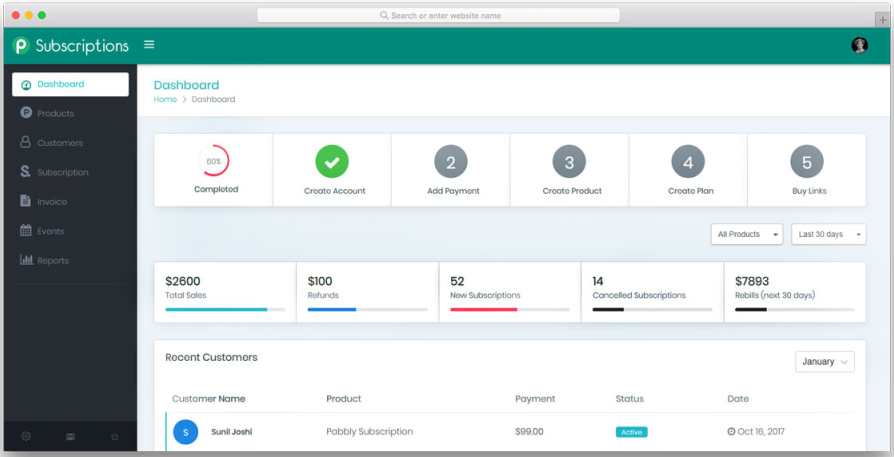Subscription Management Software Buyers Guide
This detailed guide will help you find and buy the right subscription management software for you and your business.
Last Updated on November 06, 2023The billing process for subscription-based services isn't easy. It requires you to do all the following tasks:
Process online transactions in bulk
Manage tiered-pricing structures and discounts
Remind customers about the due dates of subscription renewals
Create invoices for successful transactions
Provide terms of service
For a small business, using spreadsheets and other manual methods to do these tasks can be time-consuming and frustrating. Moreover, manually managing bills could result in introduced errors, leading to revenue loss and a poor customer experience.
With subscription management software, your small business can automate the process to ensure error-free and hassle-free subscription billing. This results in a better customer experience that generates more revenue.
To help you choose the right software for your business, this guide will cover the "what" and "how" of subscription management software.
What is subscription management software?
Subscription software allows users to manage the billing and collections processes for services that charge on a recurring basis. The software is a mix of the following three solutions:
Billing management: This software helps businesses bill their clients more efficiently. It allows them to allocate products or services to customers and track the usage of service. They can also manage access permissions based on the terms of service.
Customer management: This software allows users to record customer data and use it to prepare bills, information circulars and emails.
Payment processing: Subscription management solutions also help businesses collect customer payments via different modes such as online, credit cards and mobile payments. This is often an important software integration.

Client dashboards in Pabbly Subscriptions (Source)
What are common features of subscription management software?
The first step in selecting a subscription management solution is to understand its features. Analyzing the offerings of various subscription management solutions will help you shortlist products that are better suited to your business needs.
The first step in selecting a subscription management solution is to understand its features. Analyzing the offerings of various subscription management solutions will help you shortlist products that are better suited to your business needs.
Subscription billing | Automate the notifications, collection and invoicing of recurring bills. Users can also manage different pricing models such as tiered pricing and volume pricing. |
Payment processing | Collect payments from customers using third-party payment processors such as PayPal and Stripe. |
Invoice history | Track historical invoice data for each customer. This information is particularly useful during audits as proof of payment and revenue generated. |
Multi-period recurring billing | Bill customers for the varying duration of service such as by month, quarter, half-year or annual. Users can also roll out discounts for long-term contracts, e.g., annual packages. |
Multi-tiered pricing | Manage the pricing tiers based on usage levels. This is helpful in online services, such as email marketing solutions, which charge for the number of emails or subscribers. |
Reporting | Create reports on different subscription metrics and KPIs, e.g., churn rate, revenue and subscriber attrition rate. |
What type of buyer are you?
Based on our research, we've identified two broad categories of subscription management software buyers. Here are the details of each category:
eCommerce businesses. These buyers need to manage online access, authorization, billing and payments on a large scale. They require software that offers subscription billing, multi-period recurring billing, payment processing and reporting.
Brick-and-mortar shops and real estate firms. These buyers focus on customer payments. They need to accept payments via different modes such as by cards and near-field communication (NFC) devices. They need software that supports credit card readers, NFC devices, mobile devices and online payment methods.
What are benefits and potential issues of subscription management software?
There are many benefits of using a subscription management solution. It automates recurring billing based on pricing tiers, packages, discounts etc. It also sends payment reminders to customers, automates payment collection and records transactions and invoice history, which are useful during audits.
However, there are some potential issues that could arise if you fail to consider the following factors:
Data portability. Before purchasing a solution, ensure that it offers data portability to help users migrate to other software, when needed. The feature ensures that a record of historical purchases and invoices is available even after you move to a new solution.
Scalability. Ensure that the software is able to easily add new users as your business expands. It should also be able to handle a sudden increase in workload to accommodate increased demand during peak sales periods such as Christmas.
Accounting integration. If you currently use an accounting solution, choose software that integrates with it. This will ensure that your accounting books are up-to-date after every transaction.
What are the market trends of subscription management software?
The market for cloud products is growing fast, driving the demand for subscription-based products and services. The growth has also triggered a disruption in the subscription software space, with vendors making frequent upgrades to gain market share.
For successful deployment, ensure that the software you select incorporates recent market trends. Here are two key trends you should know about:
Cloud pushes adoption rates among small businesses. As businesses digitize their processes, subscription-based offerings are increasing in number. This pricing model lets you spread the costs across the customer base, making your products and services more affordable. This trend will drive the adoption of subscription software until 2023.
Smart “dunning" is the next big thing. Dunning refers to the process of retrying a transaction after payment failure. However, numerous retries can lead to a bad customer experience. Smart dunning uses machine learning to find the optimal time for payment processing and retrying, reducing customer involvement. With more and more online transactions, we expect smart dunning to be a core software feature by 2022.